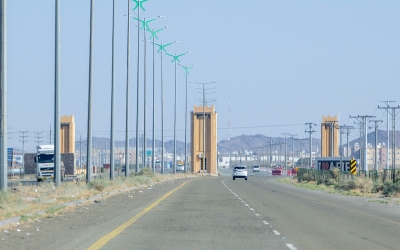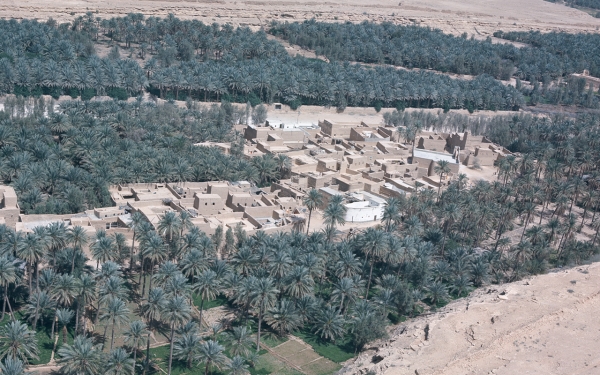
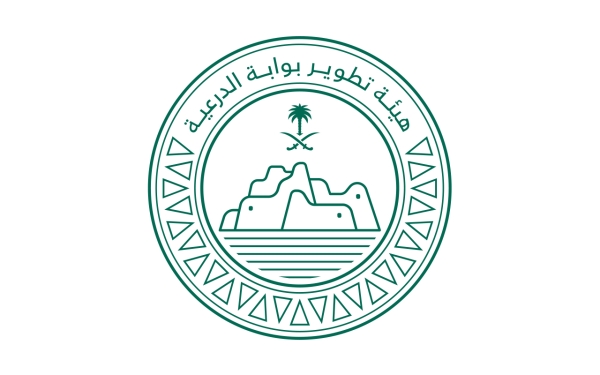
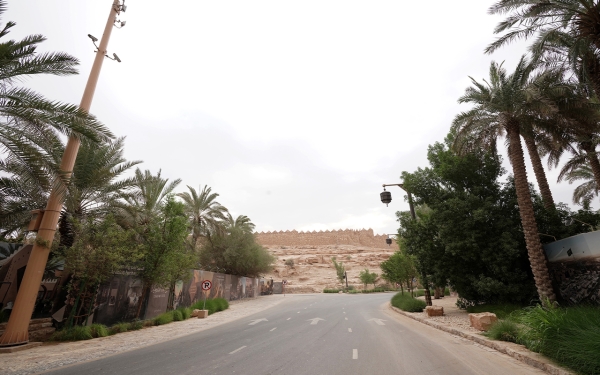
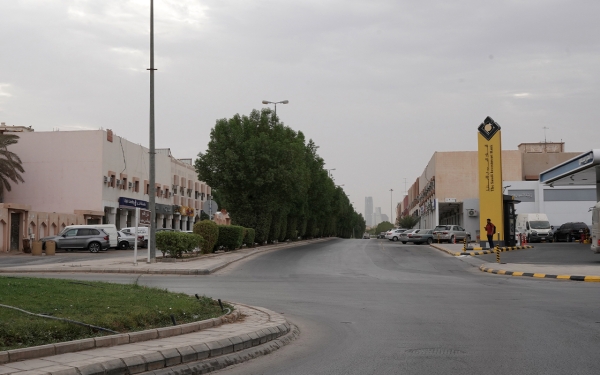
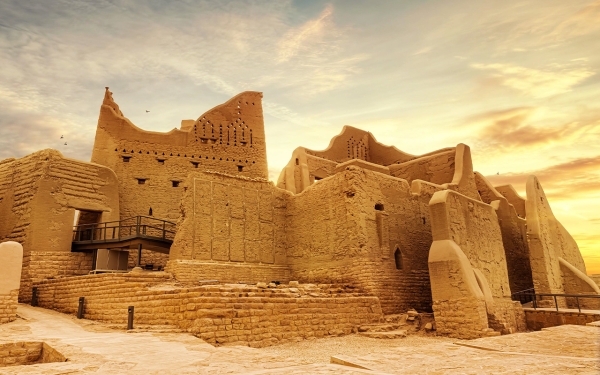
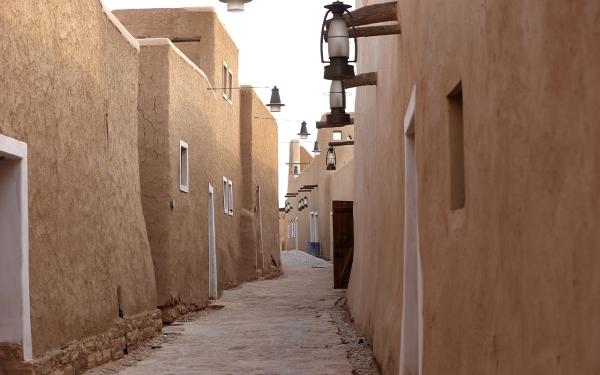
Diriyah Governorate (romanized: Muḥāfad͟hat ad Dirʻiyah) is the capital of the First Saudi State founded by Imam Mohammed Bin Saud in 1727, and the first homeland of the ruling family, Al Saud. Diriyah is located in the center of the Arabian Peninsula, in the northern part of the capital of the Kingdom of Saudi Arabia. It is administratively affiliated with Riyadh Province. The city includes Turaif neighborhood, the Jewel of the Kingdom, which is one of the largest mud neighborhoods in the world and was registered in UNESCO's World Heritage List.
Diriyah Project is the fifth major project owned by the Public Investment Fund that seeks to achieve the targets of Saudi Vision 2030. Moreover, the project supports the National Tourism Strategy aimed at hosting one hundred million tourists from all over the world by 2030.
Diriyah is the first province in the Kingdom. The Diriyah Gate Development Authority, which was established by royal order in 2017, was entrusted with the city's urban, economic, social, and cultural development. Other tasks include managing and protecting the environment, providing and improving its needs from public facilities and services, in addition to building and strengthening the future of Diriyah.
The geography of Diriyah
Diriyah, historically called al-Auja, is located on the banks of Wadi Hanifah, twenty km from the center of Riyadh.
Designation of Dariyah Governorate
When it comes to its designation, historians believe that the term Diriyah was first used to refer to a town in Qatif on the coast of the Arabian Gulf. It was inhabited by the grandfather of Al Saud, Mani' Ibn Rabi'a al-Muraydi. Then, this name was given to the place where Mani' stayed in the upper Wadi Hanifah, within al-Mulaybeed and Ghussaibah.
Moreover, Diriyah was historically called al-Auja, since this designation is affiliated with the city's hilly terrain on Wadi Hanifah. Moreover, the expression The People of al-Auja was used to refer to an essential chivalry associated with the Saudi State that extends throughout the history of the royal family (Al Saud), in the center of the Arabian Peninsula. This led to the establishment of the modern Saudi state that endures to this day.
Diriyah's location and borders
Diriyah is located in the center of the Arabian Peninsula in the northern part of Riyadh Province, specifically in the northwest of the city of Riyadh, at no more than twenty km from the center of the capital. It is around 700 m above sea level, with the cities of al-Jubaylah and al-Uyaynah located to the north.
It is bordered to the east by the city of Riyadh, to the west by Wadi Hanifah and the mountainous areas, to the north by al-Amaria Road, and to the south by Irqah Center. The city is connected to the northern governorates by Salbukh Road, which separates it from Riyadh City. After the urban sprawl, the long distance that separated Diriyah from Riyadh was reduced.
The demography of Diriyah
The population of Diriyah is estimated at ninety-six thousand people, according to the 2022 Saudi census conducted by the General Authority for Statistics. It spans 2,020 km and represents 0.54 percent of the total area of Riyadh Province. It is served by King Khalid International Airport, which is twenty-five minutes away from the city. Moreover, Diriyah is accessible through Riyadh Metro in less than three minutes on foot or in no less than fifteen minutes by car from the heart of the capital, Riyadh.
Weather in Diriyah
Diriyah has a continental climate, which is hot in the summer and cold in the winter. The maximum temperature rate in the summer exceeds 43 degrees Celsius. The small temperature rate in the winter is less than 8 degrees Celsius, with a rainfall rate of 100 mm annually. Moreover, relative humidity fluctuates between 20 percent in the summer months and 50 percent in the winter months. The general direction of the prevailing wind is northwest, although the direction of the wind and its speed are linked to low-pressure cell sites and how low the pressure is reduced.
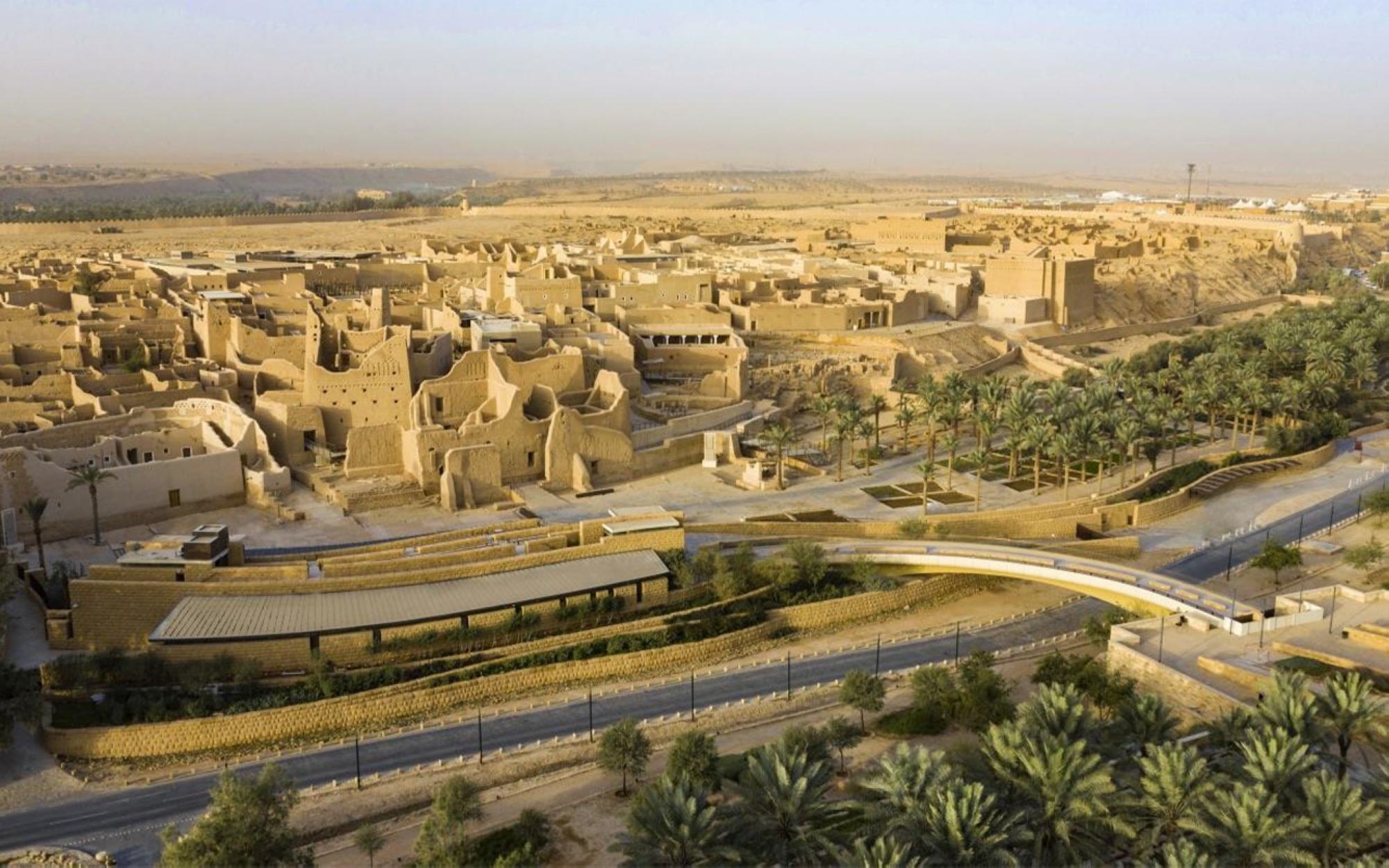
Natural environment in Diriyah
Wadi Hanifah is the most important natural landmark extending within the borders of Diriyah Governorate. Its length exceeds 120 km, its depth ranges from ten to 100 m, and its width reaches 100 to 1,000 m maximum. It extends from northwest to southeast, flows from the west of al-Uyaynah, and reaches al-Sahba in Riyadh, with an average slope of 2.8 m. Wadi Laha and Wadi Laban are the two main tributaries that flow into Wadi Hanifah.
Within Diriyah's lands, the valley is characterized by its wide sedimentary terraces, as the deep layers of silt deposits created by the floods form a fertile soil that supports Diriyah's orchards and palm trees. These sediments also formed a reservoir for subsurface water, which is fed by the valley stream from one season to another. Moreover, agriculture in Diriyah was based on shallow wells.
The Wadi Hanifah Dam was built to support groundwater sources and provide water to irrigate agricultural areas located near the dam, in addition to increasing the water level in the wells located behind it.
History of Diriyah
The history of human settlement in Diriyah dates back to prehistoric times, as archaeological excavation teams found evidence of settlements from the Stone Age on the banks of Wadi Hanifah. In the modern era, settlements in the city date back to more than five centuries when established by Mani' al-Muraydi, the ancestor of Al Saud ruling family, in 1446. Its emirate was then ruled by his sons and grandchildren until the rule of Imam Mohammed Bin Saud, who founded the First Saudi State in 1727 and made Diriyah the capital. The city served as the capital of all the rulers of the First Saudi State until the latter ended.
Establishment of Diriyah
The founding of Diriyah goes back more than five centuries when Mani' al-Muraydi decided to move with his family to the center of the Arabian Peninsula to establish the city. He was living with his relatives in the east of the Arabian Peninsula and settled in a place near the town of Qatif called Diriyah.
In 1446, Mani' al-Muraydi corresponded with a relative called Ibn Dir'a who was influential in al-Yamama. As a result, Mani’ traveled with his family, crossing during his journey from the east of the Arabian Peninsula to the barren sands of Dahana all the way to Wadi Hanifah. When he reached the valley, Ibn Dir'a welcomed him and the two leaders agreed to restore the glory of their ancestors. They took control of the region and secured the pilgrimage and trade routes. Ibn Dir'a granted two of his lands to Mani' (Al-Mulaybeed and Ghussaibah), which were then referred to as Diriyah. Mani' transformed al-Mulaybeed into an agricultural center and built around Ghussaibah a wall, making it the seat of his emirate and his governance.
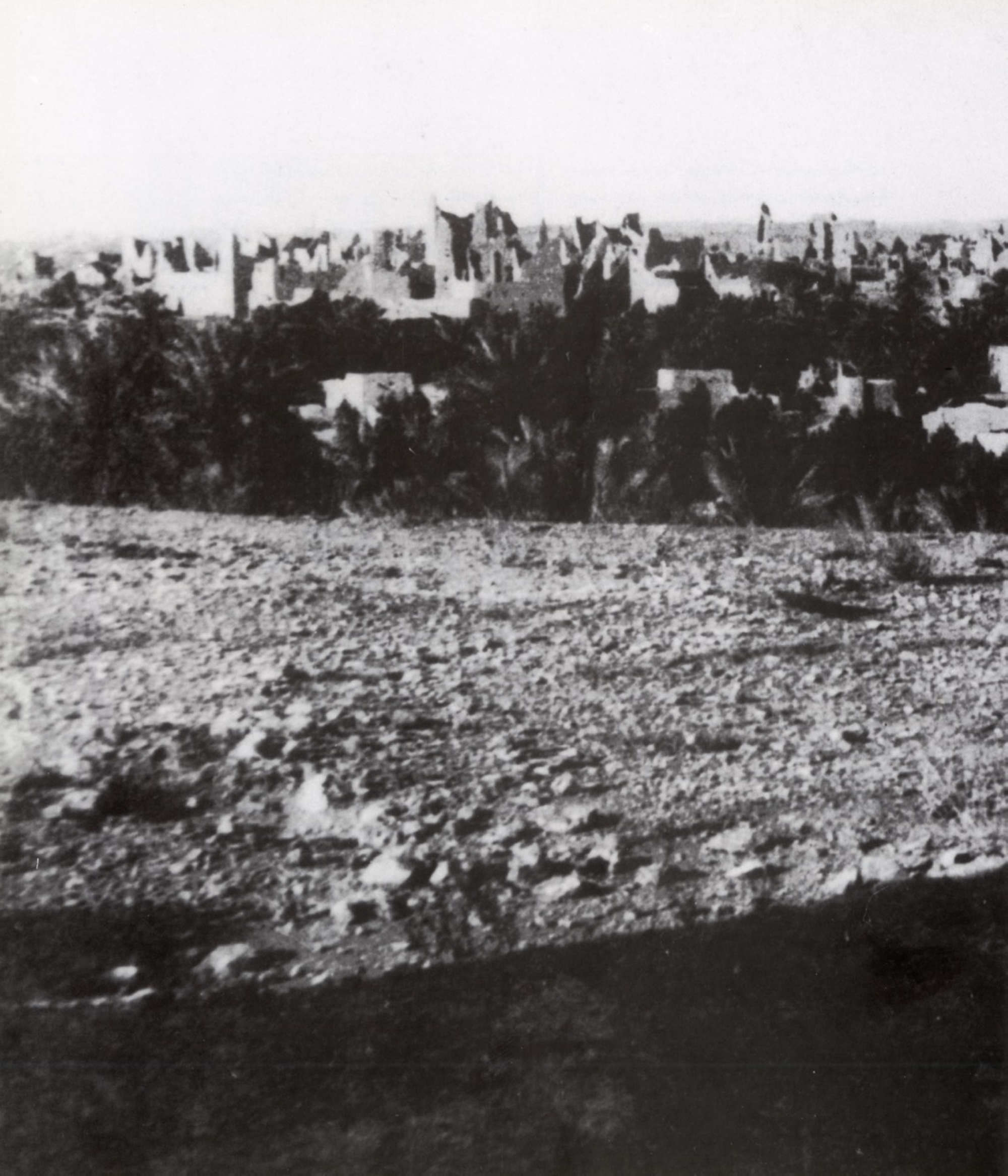
Diriyah, the capital of the First Saudi State
The First Saudi State was established in 1727, with Diriyah as its capital. Four rulers assumed power: Imam Mohammed Bin Saud who established and ruled the First Saudi State for forty years, followed by his son Abdulaziz Bin Mohammed, then Saud Bin Abdulaziz, and finally Abdullah Bin Saud.
The imams of the state followed the law is above all policy, which expanded the state’s borders to al-Ahsa, Najd, al-Hijaz, and Tihamah. As a result, Makkah al-Mukarramah and al-Madinah al-Munawwarah were liberated. The state wielded influence in the whole country to preserve security and property, leading to stability. The capital, Diriyah thus became a destination for students, merchants, and people seeking the safety of their lives and property, preventing the loss of or assault on their properties.
Historic importance of Diriyah
After its establishment by Mani' al-Muraydi, Diriyah grew further, which led to an increase in its agricultural productivity that exceeded its self-sufficiency level. It became a center for trading and exchanging goods and attracted people with an interest in agriculture and trade due to the fertility of its lands and the abundance of its production.
After the formation of the First Saudi State, Diriyah became the first center for advancement. Its rulers followed a cohesive architectural and urban program, thus making it a center of science, culture, and commerce. It also became the main control point on the Hajj route between the eastern and western provinces of the country, and the power broker in the trade route linking north and south.
Due to its good reputation, Diriyah became a meeting place for travelers coming from Africa, Asia, and Europe. It became the strongest city of the First Saudi State thanks to its military, political, and religious development.
The ancient construction of Diriyah
Diriyah is one of the largest mud cities in the world. The foundations and columns of all its structures were built of stones, while its walls and partitions were built of mud and tamarisk trunks and branches. As for the roofs, they were built from palm leaves. Turaif neighborhood, which was founded during the eighth century, is the most prominent destination of Diriyah. It is also recorded in the UNESCO World Heritage List. Moreover, Salwa Palace, which is Diriya’s biggest palace, and Imam Mohammed Bin Saud Mosque, which is the biggest mosque of the First Saudi State, are both located in Turaif neighborhood.
Al-Bujairi district is the most important district in Diriyah after Turaif neighborhood. Samhan neighborhood, on the other hand, is one of Diriyah's state-owned mud neighborhoods. Its buildings are estimated at thirty-six, with one or two stories. The Diriyah Gate Development Authority is working on the rehabilitation and development of this district in accordance with the archaeological style of hotels. The Saudi Ministry of Culture depends on Spanish consulting firms to develop the neighborhood and preserve its heritage as per international standards.
King Salman Bin Abdulaziz Al Saud’s interest in Diriyah
The Custodian of the Two Holy Mosques, King Salman Bin Abdulaziz, paid great attention to Diriyah by first launching the Historic Diriyah Development Program when he was Prince of Riyadh Province and head of the Supreme Commission for the Development of Riyadh (currently the Royal Commission for Riyadh City). The program began by forming a committee to study the development of Diriyah based on an initiative presented by Prince Sultan Bin Salman Bin Abdulaziz on December 29, 1996. This committee was entrusted with developing a comprehensive cultural development program to highlight the historical role of Diriyah and make it a cultural and civilizational center.
On October 8, 1998, a royal order was issued approving the proposed program to develop historic Diriyah under the supervision of the Supreme Commission for the Development of Riyadh (currently the Royal Commission for Riyadh City).
The restoration and rehabilitation project was launched to preserve the historical heritage of Diriyah and transform the region into a site for sustainable historical and cultural tourism. The commission assumed responsibility for studies preparation and implementation, in coordination with the General Authority for Tourism and National Heritage (as previously called), the King Abdulaziz Foundation for Research and Archives, and Diriyah Governorate and its municipality. All efforts for the development and rehabilitation of Diriyah were fruitful. In 2010, UNESCO added Turaif neighborhood in Diriyah to its World Heritage List.
Diriyah in Vision 2030
Diriyah encompasses cultural, heritage, and tourist attractions that highlight more than three hundred years of the Kingdom’s authentic culture and history. In 2023, His Royal Highness Prince Mohammed Bin Salman Bin Abdulaziz, crown prince, prime minister, and chairman of the Council of Economic and Development Affairs, announced that Diriyah Project was the fifth major project owned by the Public Investment Fund, as part of the plans aimed at supporting Saudi Vision 2030. The project will attract twenty-seven million local and international visitors by 2030.
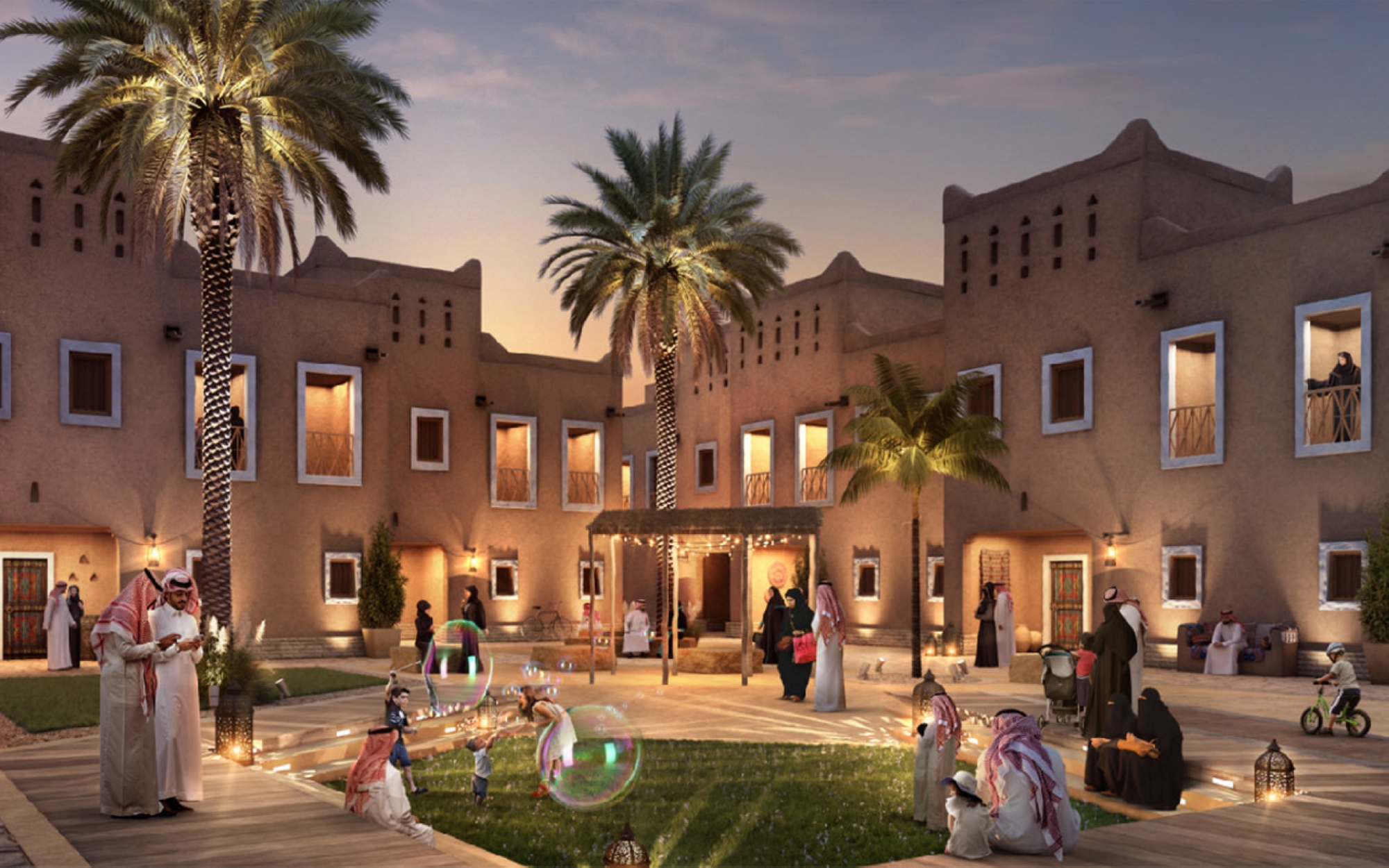
Diriyah Gate project
The Public Investment Fund has transformed Diriyah into the largest cultural and heritage destination in the world through the Diriyah Gate project, one of its major projects supporting the achievement of Saudi Vision 2030, which was launched on November 19, 2019. The project aims to preserve, protect, and develop Turaif neighborhood, one of the historic UNESCO World Heritage Sites in Diriyah. Moreover, it will design a distinctive destination with various experiences and lifestyles that celebrate Saudi culture by promoting Arab and national heritage both locally and internationally.
Diriyah Gate project also introduces a number of initiatives to serve the local community, which creates a stimulating and supportive environment for creativity and inspiration, and improves the quality of life for residents. Moreover, the project ensures financial sustainability without compromising culture and heritage preservation, and raises awareness of the Kingdom for tourists, as a cultural and entertainment destination by activating heritage assets, and hosting international cultural and entertainment events to increase the number of visitors locally and internationally.
The project's first phase includes developing the famous Bujairi Province using the most prominent and latest environmental and urban standards in rehabilitating the heritage and historical sites worldwide. Moreover, it involves establishing an exceptional lifestyle for tourists, guests, and visitors from inside and outside the Kingdom over an area that exceeds seven km. The project represents a new era in construction, architecture, and traditional design, as well as hospitality worldwide. Its masterplan includes an area of 3 km designated for pedestrians, five squares for gathering and exploration, including King Salman Square, Samhan Amphitheater, Monument Square, al-Masjid Square, and a historic Village Square, in addition to the launch of six museums, the establishment of five academies affiliated with the Arts District, one hundred restaurants, and cafes and shopping areas from different parts of the world. The project will also designate several resting and relaxation sites, including more than twenty international hotel brands and integrated resorts overlooking Wadi Hanifah.
The Diriyah Gate project includes a number of sub-projects:
- Turaif historical neighborhood project.
- Wadi Hanifah project.
- Al-Bujairi district project.
- King Salman Square project.
- King Salman University project.
- Museum of Al Saud House project.
Economic future
Diriyah Project diversifies the local economy by supporting the development and empowerment of vital sectors, such as tourism and culture. It aims to attract twenty-seven million local and international visitors by 2030. This goal supports the National Tourism Strategy, which seeks to host one hundred million tourists from all over the world by 2030.
The project also launches several new investment opportunities through the various stages of development and implementation, and provides thousands of job opportunities, in addition to creating private-sector partnership opportunities and presenting initiatives that raise the quality of life in the province.
Consequently, a SAR240 billion budget was approved to develop Diriyah, create cultural interfaces and adopt contemporary lifestyles across the city, accommodate one hundred thousand residents, welcome twenty-seven million visitors annually, build twenty international hotels and three thousand residential regions, open one hundred restaurants and outdoor courtyards, prepare twenty museums and 3,100 luxurious hotel rooms, and build four sports and entertainment fields.
Diriyah Gate Development Authority
Diriyah established a development authority entitled Diriyah Gate Development Authority (DGDA) which is under the supervision of His Royal Highness Prince Mohammed Bin Salman Bin Abdulaziz who is also the chairman of its Board of Directors. It aims to improve the culture and architecture of Diriyah, as it is the birthplace of the First Saudi State. Other objectives of DGDA include highlighting the historical aspect of Diriyah, encouraging its residents to preserve and protect its heritage, and shedding light on its economic, cultural, and tourist value by introducing fashion, music, arts, and entertainment.
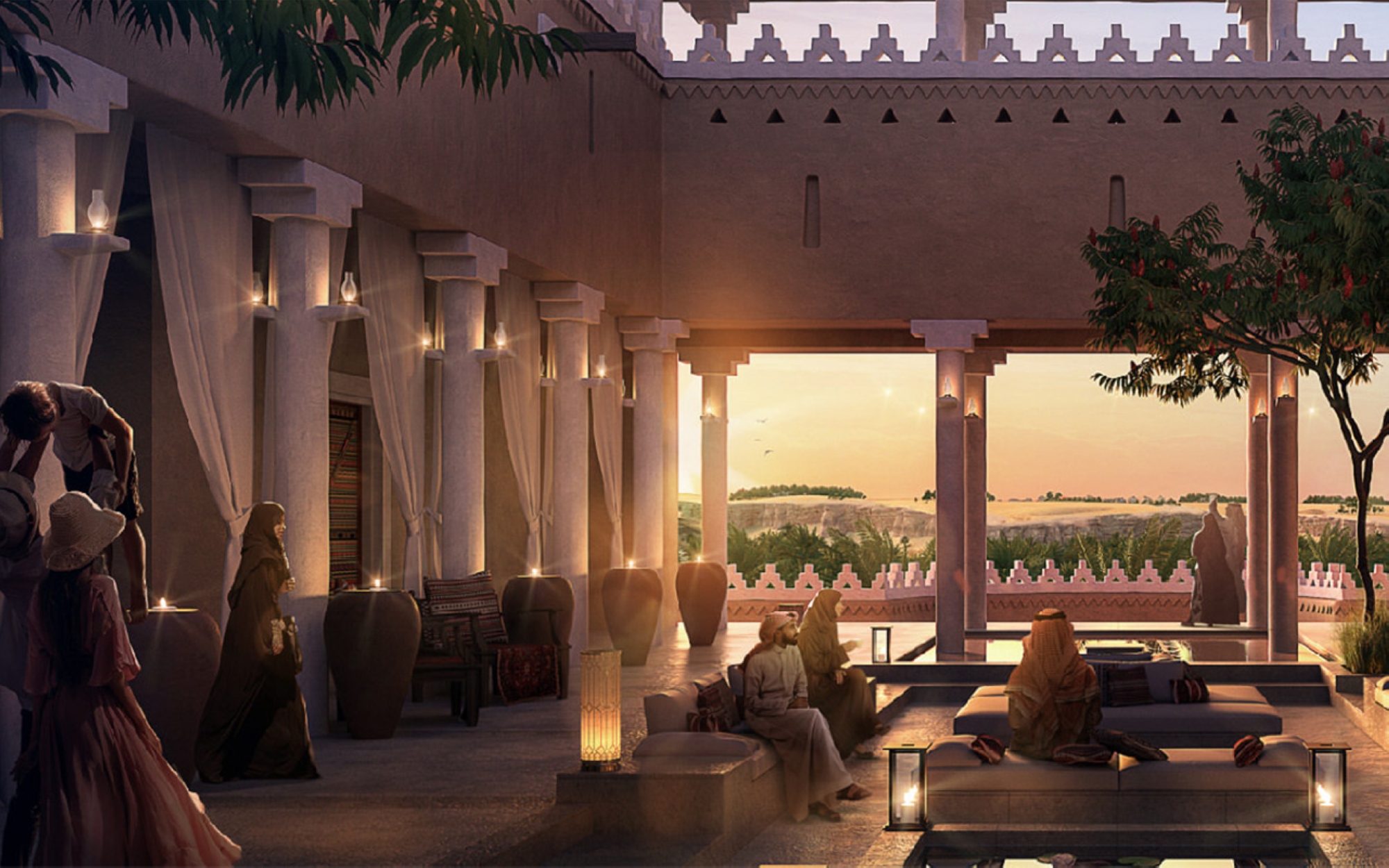
About the authority
Diriyah Gate Development Authority was established on July 20, 2017, to assume responsibility for developing and preserving the historic Diriyah site by serving the local community. Moreover, the authority seeks to enhance Diriyah’s position to become an international tourist destination, and one of the largest and most important locations for events and activities in the world. The authority supervises the development of Diriyah over an area of up to 190 km, which is equivalent to the area of Santa Catalina Island, California, in the United States of America.
Diriyah Gate Development Authority assumes several roles, including the urban, economic, social, and cultural development of Diriyah Governorate, in addition to managing and protecting the environment and providing the necessary public utilities and services. The authority seeks to enhance Diriyah and secure a better future for the city.
On November 19, 2019, the authority launched the Diriyah Gate project to transform the city into an international tourist destination that focuses on culture and heritage. In addition to development, its competencies include seeking the assistance of studies and planning centers to develop implementation plans for the project, and following up on planning related to the necessary infrastructure and its implementation, in coordination with the relevant agencies. Its role is also concerned with establishing or contributing to companies, as well as establishing investment and endowment funds to ensure that the authority performs its tasks and achieves its objectives.
The authority's programs
Diriyah Gate Development Authority launched a number of programs to attract local talent and build a robust economy that enhances the future of the Kingdom. In 2022, the Diriyah Engineers Development Program was launched to prepare Diriyah's Saudi engineers with international skills and experiences, capable of playing an effective role in the authority's various development and design projects.
The first version of the Diriyah Engineers Development Program was launched in 2020 to bridge the gap between undergraduate and professional life. The program aims to provide Saudi university graduates from Diriyah with a wide range of training and professional opportunities. It focuses on developing the most crucial professional skills, such as project management, presentation skills, and effective communication, as well as personal skills, including analytical thinking and communication, proactivity, time management, relationship building, and making breakthroughs.
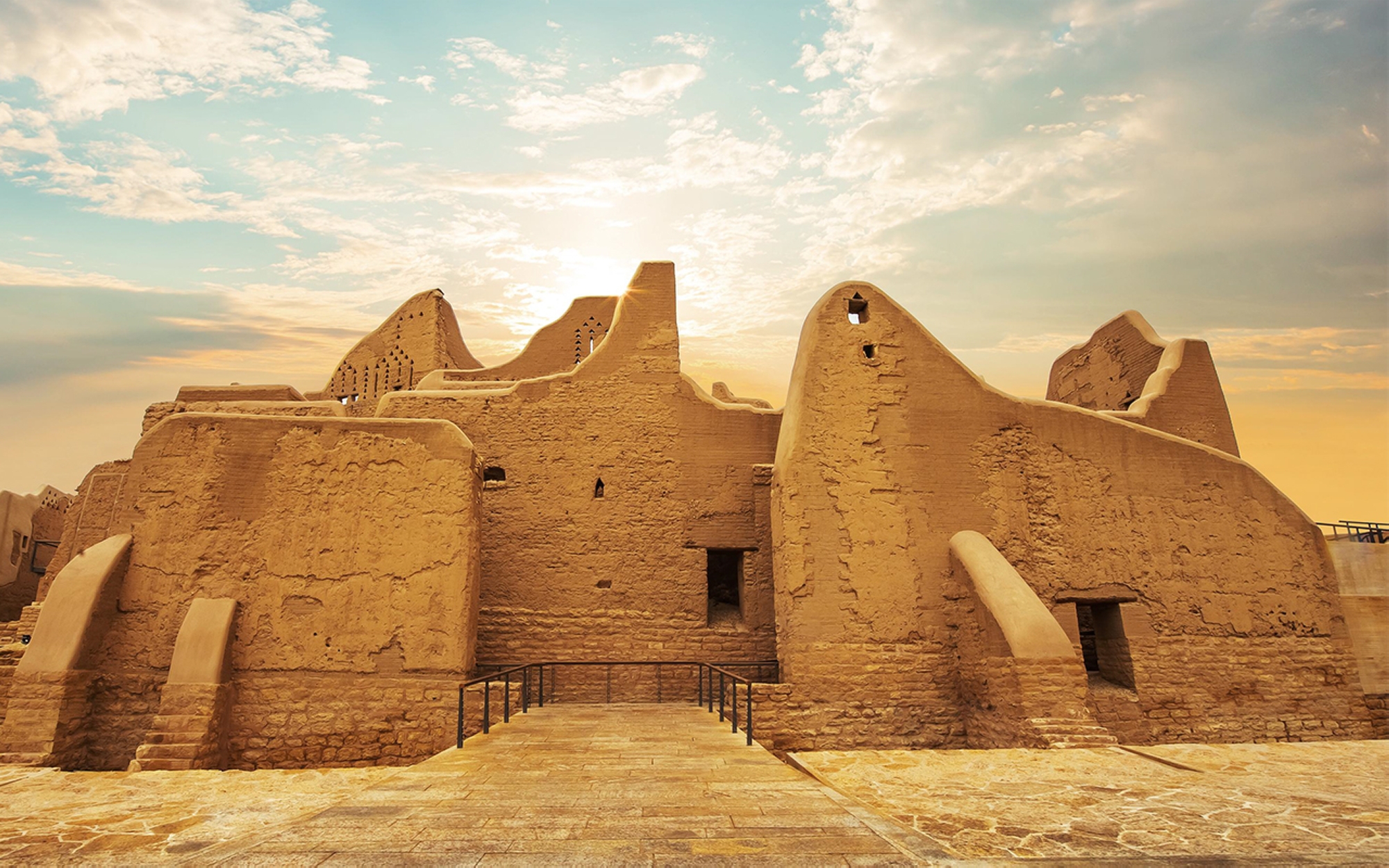
Developmental projects
Diriyah is a center of culture and heritage and a prominent tourist destination in the Kingdom. Therefore, it is a hub for many development projects that create a vibrant economy. The city enhances job opportunities, living standards, and the quality of life for residents.
Historic Turaif neighborhood
Turaif is one of the neighborhoods that make up Diriyah and is the most famous historically. It was built in the eighteenth century and is the largest mud city in the world. It is home to Salwa Palace, which was the seat of government of the First Saudi State starting in 1766 when it was built by Imam Abdulaziz Bin Muhammad bin Saud, the second Imam of the state, in addition to Imam Mohammed Bin Saud Mosque, the largest mosque of the Saudi State at the time. It is the second Saudi site that was added to the UNESCO World Heritage List.
The development of historic Turaif neighborhood is one of the Diriyah Gate projects, a major project supporting the achievement of Saudi Vision 2030. As a leading destination for history enthusiasts, the neighborhood has witnessed a continuous renaissance, improvements, and a significant increase in infrastructure and services. Its heritage elements are experiencing a period of renewal, as rubble is being removed from its buildings, and its architectural elements and archaeological buildings are being documented. Drawings, photographs, and videos are used to document the history of the neighborhood. Moreover, its external and internal components are being restored and reinforced with the required building materials to prevent cracks, in addition to improving external facades overlooking the squares and roads.
Salwa Palace is one of the most important historical monuments located in Turaif neighborhood. It was founded by Imam Abdulaziz Bin Mohammed Bin Saud in 1765. It is historically known as the home of the first founders of the royal family. The palace dates back to the early eighteenth century, when it served as the seat of government for the First Saudi State.
On the opposite side of the palace, a new visitor reception center was established to provide tourist and guidance services. This center contains the latest necessary technical technologies to serve tourists, and offers audio drama shows with spotlights narrating the history of the First Saudi State, in addition to demonstrations of various locations. The neighborhood also includes several museums, most notably the Diriyah Museum in Salwa Palace, the Social Life Museum, the Military Museum, the Horse Museum, and the Museum of Treasury (Beit al-Maal).
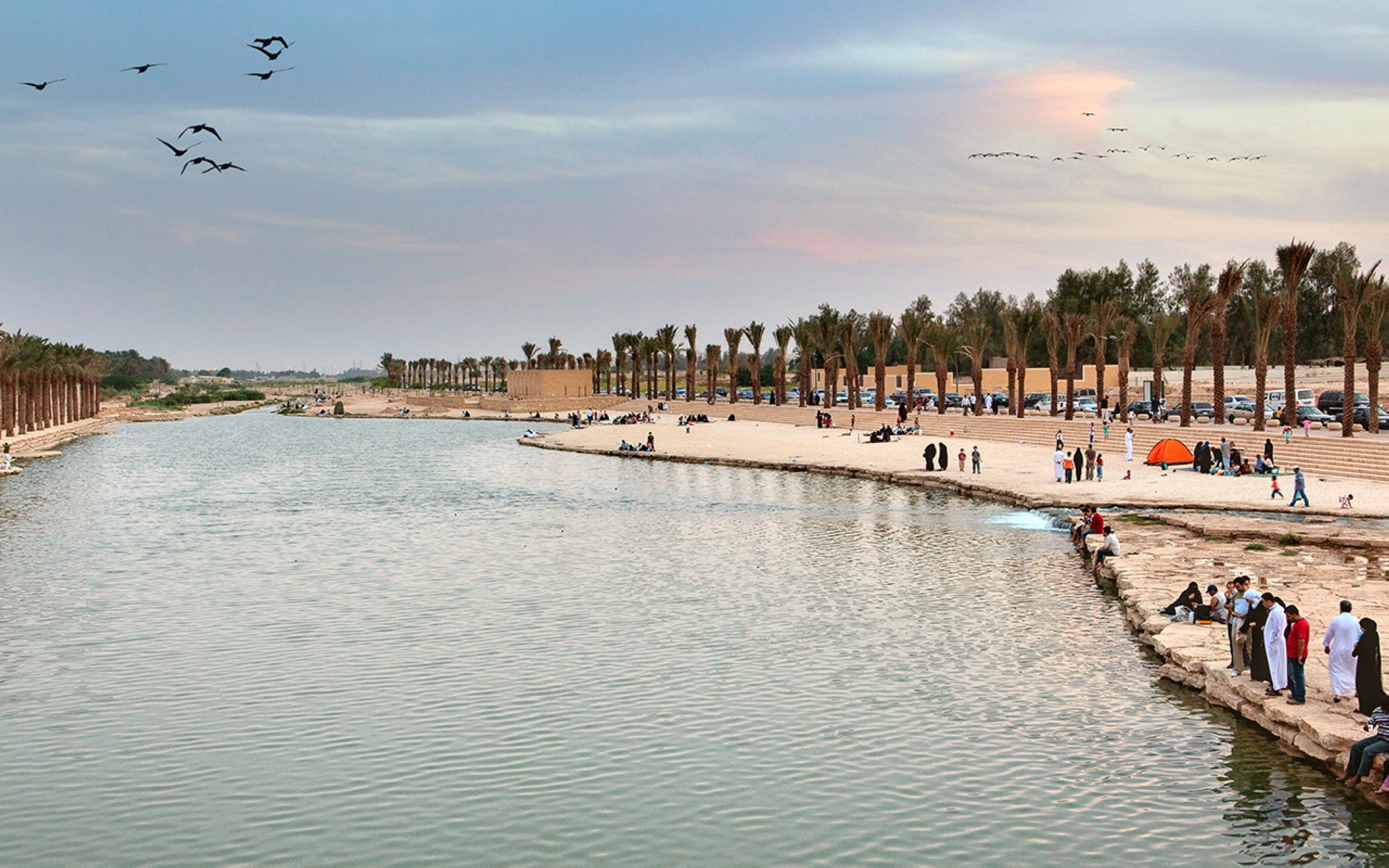
Wadi Hanifah
The first step to developing Wadi Hanifah began in 1988 when the Royal Commission for Riyadh City (formerly the High Commission for the Development of Arriyadh) made it an environmentally protected area and a special development area under its supervision. In 1415 H, the authority approved a comprehensive plan to rehabilitate the valley and its tributaries. After announcing the Diriyah Gate project in 2019, which is one of the major projects for the achievement of Saudi Vision 2030, the development and rehabilitation of Wadi Hanifah was transferred to the Diriyah Gate Development Authority.
Work is underway to develop an area of 2 km from Wadi Hanifah to serve as open sites for tourists and visitors to enjoy the natural views of the valley. Other works include the development, rehabilitation, and protection of palm groves and ancient local farms in the province, and the establishment of new pedestrian paths and picnic areas.
Al-Bujairi District
Al-Bujairi district is one of the historical neighborhoods in Diriyah. From its western side, it overlooks the natural elements of Wadi Hanifah. It is one of the historical neighborhoods included in the developmental works within the Diriyah project, one of the major projects to achieve Saudi Vision 2030. Although it has been targeted by development projects, it still maintains its historical character.
Al-Bujairi district's developmental work included the construction of streets with a historical architectural style, natural landscaping, and scenic paths for pedestrians, bicycles, and horse riding. The neighborhood will also be a major center for international restaurants in the capital, Riyadh.
The neighborhood also includes al-Bujairi view, overlooking the historic Turaif neighborhood, which is one of the finest dining destinations in Diriyah, with over twenty of the best local and international restaurants and distinguished cafes, offering a unique atmosphere surrounded by traditional architecture.
Tourism in Diriyah
Diriyah is one of the prominent tourist destinations in the Kingdom, combining traditional Najdi architectural style with contemporary architecture that showcases the Kingdom’s origins and entrenched values. The Diriyah Gate project will also attract twenty-seven million local and international visitors by 2030. This goal supports the National Tourism Strategy, which seeks to host one hundred million tourists from all over the world by 2030.
Diriyah Season
The first edition of Diriyah Season was launched in 2019, contributing to the development of the tourism sector in the entertainment, sports, tourism, and cultural fields by organizing various activities that promote economic prosperity and enhance the community's vitality. Diriyah Season is part of the Diriyah Gate Development Authority's efforts to reach twenty-seven million visitors annually. Diriyah is a destination for culture, entertainment, relaxation, shopping, and hospitality, as it encompasses various facilities, such as museums, hotels, shops, and restaurants.
Diriyah Season involves several world sports tournaments with international stars and famous figures. As part of the Diriyah Season events, a number of world football championships were organized, such as hosting the Spanish Super Cup for the third time in a row, with the participation of four teams: Real Madrid, Barcelona, Valencia, and Real Betis. Moreover, the Diriyah Cup brought together al-Hilal SFC and Newcastle United, as well as football events included the Italian Super Cup, which was held for the third time.
Diriyah Season organized a number of different sports within international championships. In terms of horse racing, Diriyah hosted the Longines Global Champions Tour and the Equestrian Festival. As for boxing, the historic Diriyah fight was hosted as part of the season's events, in addition to the Diriyah Tennis Cup, which is the first international tennis championship held in the Kingdom. In speed racing, Diriyah organized several championships, including the UCI BMX Freestyle World Cup and the CORE Diriyah ePrix.
International sports in Diriyah
By hosting international sports competitions, such as Formula E races, Diriyah seeks to become a promising land for motorsports. The city hosted this type of race for the first time in 2018 and once more in 2019. In 2021, this type of racing in the Kingdom faced a new challenge, as it was held at night for the first time in the history of the tournament. Diriyah continued to host the first and second rounds of the 2022 Formula E, and the 2023 Formula E will be held on a 2.495 km circuit that includes twenty-one turns. Moreover, the construction conditions of this circuit were subject to the requirements of local content to compete with the best racing high-quality circuits.
Formula E Diriyah
It is one of the international Formula races, held annually in the historic city of Diriyah. The race is set to be held in the Kingdom for ten years, starting from 2018 until 2028. The Kingdom is the first country in the Middle East to open its doors to this type of racing. Unlike Formula 1 vehicles that run on petroleum products, Formula E cars are free of any carbon emissions, as they run entirely on electric power, thus making Formula E an environmentally friendly sport.
Formula E Diriyah's events constitute a comprehensive entertainment festival, which includes the Formula E Fan Village, also known as Allianz E-Village. It extends over an area of up to 180,000 sq ft (167,000 m). In addition to the main racing event, the festival includes various entertainment activities, such as artistic performances and concerts, in addition to shopping places, and others.
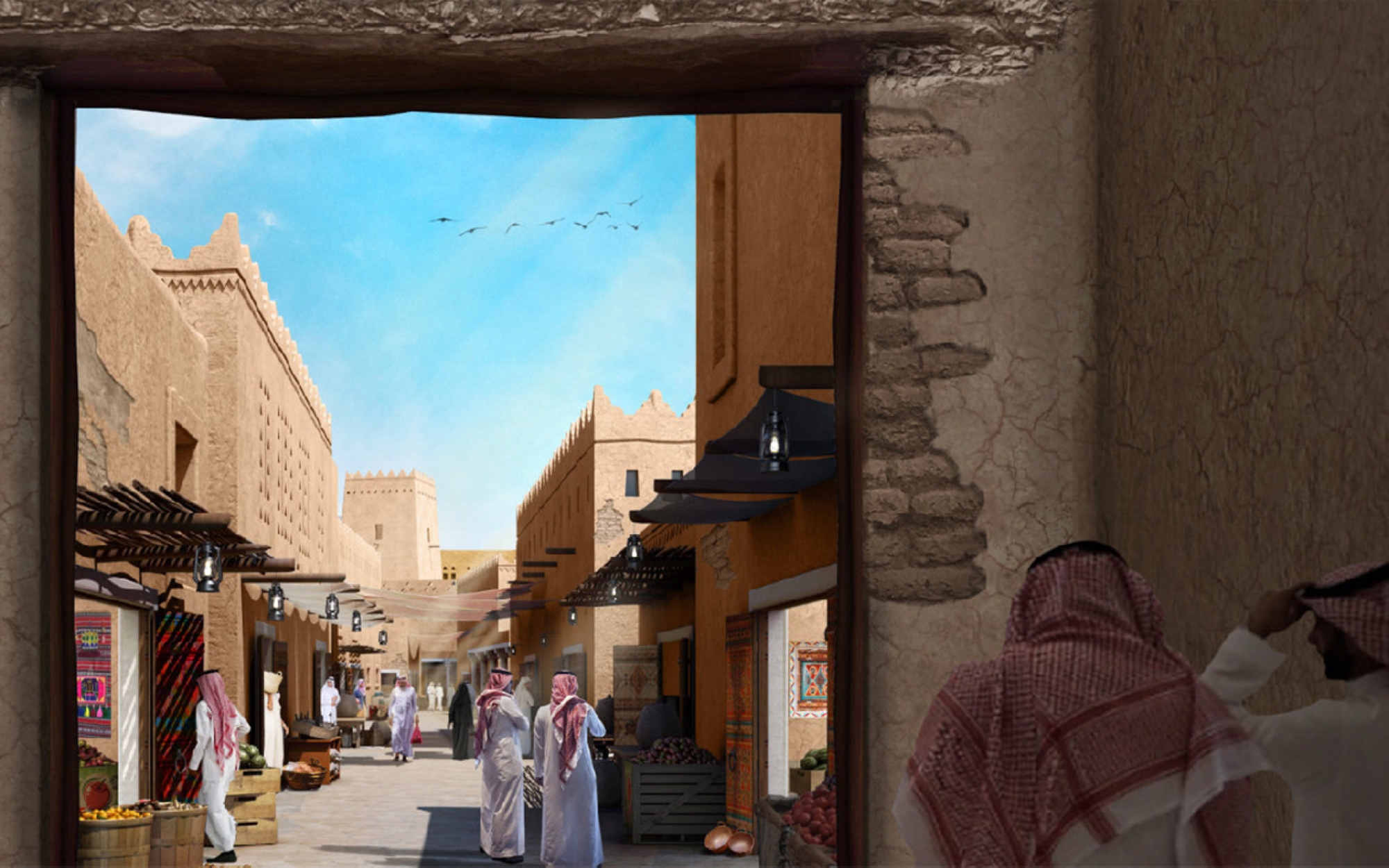
Culture and arts in Diriyah
The current image of Diriyah mirrors its historical depth that goes back to over five centuries. The city was subject to renovations, improvements, and development works in order to become the cultural capital of the Kingdom, one of the most important modern destinations in the world for culture and heritage, and a source that inspires future generations and the entire world. Diriyah encompasses more than twenty-six cultural landmarks and a number of cultural institutions and exhibitions that highlight the ancient Saudi heritage.
Capital of Arab Culture 2030
In 2021, Diriyah was chosen by the Arab League Educational, Cultural, and Scientific Organization (ALECSO) as the Capital of Arab Culture 2030 due to its historical heritage, cultural center, and role in science, culture, and trade that goes back over five centuries ago. After the capital Riyadh was chosen in 2000, this was the second time that a Saudi city was selected as the Capital of Arab Culture, thus enhancing the status of these two cities that have a great cultural and cognitive impact.
Jax District
Jax District is one of the creative districts located in Diriyah. It was launched in 2021 as a supportive platform for local talent and a reference for culture and arts. The district organizes local and international exhibitions, as well as cultural and artistic activities throughout the year.
Jax District was originally an industrial area comprising one hundred warehouses, known for its role as a logistical center for infrastructure projects in Riyadh. The Ministry of Culture renovated and developed it to become one of the first cultural districts that support art in the Kingdom. It comprises 140 different units, including art studios, exhibitions, platforms, and training halls. Moreover, the district hosts a group of cultural and artistic events, most prominently:
Diriyah Biennale
On December 11, 2021, Jax District witnessed the opening of the Diriyah Contemporary Art Biennale under the slogan Crossing the River by Feeling the Stones. The exhibition, entitled Echoes. A World between the Analogue and the Virtual showcased forty works signed by twenty-seven local artists, in addition to pieces and antiques by international artists.
The Tuwaiq International Sculpture Symposium was also held in the Jax District as part of the Riyadh Art project under the theme The Poetics of Space. This event brought together twenty sculptors from various countries and included thirty workshops and an artistic seminar, with the participation of local and international speakers. It hosted over four hundred students from different educational levels and institutions.
Contemporary Arabic Calligraphy Exhibition
Jax District organized the Contemporary Arabic Calligraphy Exhibition, launched by the Ministry of Culture on December 13, 2021. The exhibition is part of the Quality of Life Program initiatives, one of the programs supporting the achievement of Saudi Vision 2030 that celebrates Arabic calligraphy and strengthens its position in society. The exhibition also included a store for Arabic calligraphy, in addition to a live show with the participation of professionals in the art of Arabic calligraphy.
Jax Art Festival
The Ministry of Culture also launched the Jax Arts Festival at the headquarters of the Diriyah Biennale in Jax District. It consists of a group of artistic works, activities, and programs. The festival was inaugurated on July 14, 2022, and its activities lasted for ten days. Several local and international artists participated in the festival which was supported by the Quality of Life Program, one of the Saudi Vision 2030 programs.
Diriyah Art Oasis
Diriyah Art Oasis is the first specialized museum for digital arts in the world that includes related programs and training courses for arts and modern technologies, all presented in a modern, creative environment designed by Italian architect Amedeo Schiattarella. The oasis is located in al-Bujairi district. It includes six art studios, workshop halls, training and education classrooms, and work spaces for artists, in addition to a library, an art store, and modern facilities for young people.
The oasis offers various educational programs covering the following fields: arts, Artificial Intelligence, graphic design, 3D modeling, animation, digital arts, photography, production of movies, and sound arts. Moreover, the oasis will organize programs for public engagement, exhibitions, and digital arts hackathons, in addition to a new media center and contemporary artistic research.
Diriyah Art Oasis is one of the projects affiliated with the Diriyah Gate project. It involves the establishment of five academies that teach a number of local specialties, such as Arabic calligraphy, Islamic arts, Najdi architecture, mud buildings, Najdi culinary arts, theater, and Arabic music.
Museums
The city of Diriyah is the cultural capital of the Kingdom and one of its main tourist attractions. It is home to a number of national museums that highlight the history and culture of the Kingdom, which goes back more than three hundred years. Diriyah museums are also engaged in research, as they are a reference for those interested in documenting Diriyah’s culture and history.
The historic Turaif neighborhood is one of the most prominent areas with museums in Diriyah, as it includes several museums: Diriyah Museum in Salwa Palace, which presents the history of the First Saudi State and its characteristics in governance and administration through visual displays, photographs, and a number of paintings and models that tell the story of the palace and the time period during which Diriyah was the seat of government.
The Social Life Museum focuses on the daily life of the Turaif people and highlights their traditions and customs. Furthermore, the museum displays the tools and utensils that were used for different domestic purposes during the reign of the First Saudi State. On the other hand, the Military Museum showcases the weapons that were used in wars and battles, and documents Diriyah's historical defense story before the city fell.
The Horse Museum sheds light on the horse care methods that were adopted when Diriyah was most prosperous, in addition to the places that were used as stables at the time. The Museum of Treasury, which was historically the location of Bayt al-mal (House of Money), displays the currencies, endowments, scales, and trade methods, as well as the economic development witnessed by Diriyah.
Moreover, work is underway to open six other museums, which are affiliated with the Diriyah Gate project, and they are: the Museum of Al Saud House, the Museum of the Saudi State and the Arabian Peninsula, the Museum of the 100-Stories Journey, in addition to the Diriyah Arts Center, the Digital Arts Museum, and the Misk Heritage Museum.
Related quizzes
Related articles


